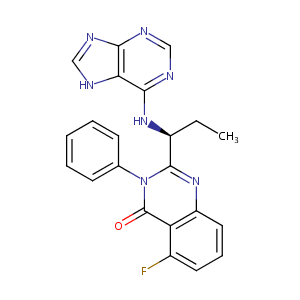| 1 |
ClinicalTrials.gov (NCT01644799) Lenalidomide and Idelalisib in Treating Patients With Recurrent Follicular Lymphoma
|
| 2 |
URL: http://www.guidetopharmacology.org Nucleic Acids Res. 2015 Oct 12. pii: gkv1037. The IUPHAR/BPS Guide to PHARMACOLOGY in 2016: towards curated quantitative interactions between 1300 protein targets and 6000 ligands. (Ligand id: 6741).
|
| 3 |
Idelalisib FDA Label
|
| 4 |
Lenalidomide FDA Label
|
| 5 |
URL: http://www.guidetopharmacology.org Nucleic Acids Res. 2015 Oct 12. pii: gkv1037. The IUPHAR/BPS Guide to PHARMACOLOGY in 2016: towards curated quantitative interactions between 1300 protein targets and 6000 ligands. (Ligand id: 7331).
|
| 6 |
Low-dose Lenalidomide for Non-severe COVID-19 Treatment Trial (GETAFE)
|
| 7 |
2014 FDA drug approvals. Nat Rev Drug Discov. 2015 Feb;14(2):77-81.
|
| 8 |
DrugBank 5.0: a major update to the DrugBank database for 2018. Nucleic Acids Res. 2018 Jan 4;46(D1):D1074-D1082. (ID: DB09054)
|
| 9 |
FDA label of Idelalisib. The 2020 official website of the U.S. Food and Drug Administration.
|
| 10 |
PI3K/AKT inhibitors aggravate death receptor-mediated hepatocyte apoptosis and liver injury. Toxicol Appl Pharmacol. 2019 Oct 15;381:114729. doi: 10.1016/j.taap.2019.114729. Epub 2019 Aug 22.
|
| 11 |
Roles of pulmonary telocytes in airway epithelia to benefit experimental acute lung injury through production of telocyte-driven mediators and exosomes. Cell Biol Toxicol. 2023 Apr;39(2):451-465. doi: 10.1007/s10565-021-09670-5. Epub 2022 Jan 3.
|
| 12 |
Induction of prolonged early G1 arrest by CDK4/CDK6 inhibition reprograms lymphoma cells for durable PI3K inhibition through PIK3IP1. Cell Cycle. 2013 Jun 15;12(12):1892-900. doi: 10.4161/cc.24928. Epub 2013 May 15.
|
| 13 |
Regulatory roles of NAT10 in airway epithelial cell function and metabolism in pathological conditions. Cell Biol Toxicol. 2023 Aug;39(4):1237-1256. doi: 10.1007/s10565-022-09743-z. Epub 2022 Jul 25.
|
| 14 |
Thalidomide and thalidomide analogues for maintenance of remission in Crohn's disease. Cochrane Database Syst Rev. 2009 Apr 15;(2):CD007351.
|
| 15 |
DrugBank 5.0: a major update to the DrugBank database for 2018. Nucleic Acids Res. 2018 Jan 4;46(D1):D1074-D1082. (ID: DB00480)
|
| 16 |
Thalidomide and Its Analogs Differentially Target Fibroblast Growth Factor Receptors: Thalidomide Suppresses FGFR Gene Expression while Pomalidomide Dampens FGFR2 Activity. Chem Res Toxicol. 2019 Apr 15;32(4):589-602. doi: 10.1021/acs.chemrestox.8b00286. Epub 2019 Mar 15.
|
| 17 |
Circulating endothelial progenitor cells in multiple myeloma: implications and significance. Blood. 2005 Apr 15;105(8):3286-94. doi: 10.1182/blood-2004-06-2101. Epub 2004 Dec 23.
|
| 18 |
Structure of the human Cereblon-DDB1-lenalidomide complex reveals basis for responsiveness to thalidomide analogs. Nat Struct Mol Biol. 2014 Sep;21(9):803-9. doi: 10.1038/nsmb.2874. Epub 2014 Aug 10.
|
| 19 |
Thalidomide promotes degradation of SALL4, a transcription factor implicated in Duane Radial Ray syndrome. Elife. 2018 Aug 1;7:e38430. doi: 10.7554/eLife.38430.
|
| 20 |
A Dual Color Immunohistochemistry Assay for Measurement of Cereblon in Multiple Myeloma Patient Samples. Appl Immunohistochem Mol Morphol. 2016 Nov/Dec;24(10):695-702. doi: 10.1097/PAI.0000000000000246.
|
|
|
|
|
|
|


